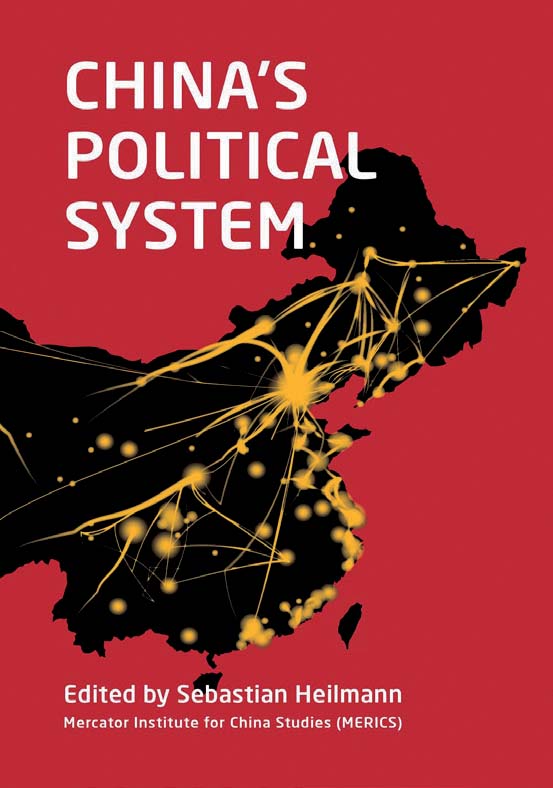Sebastian Heilmann (ed.) 2017.
China’s Political System
Lanham, MD: Rowman & Littlefield
ISBN 9781442277359
For political scientists, China is as important as it is elusive. It has developed into one of the world’s leading economies, with officials guiding market forces and state enterprises through long-term planning. Politically, China remains a single-party authoritarian state with few signs of democratization, although it is also relatively decentralized, responsive, and adaptable. Chinese politics are ever-changing, with our understanding limited by opaque party hierarchies. In light of these and other challenges, we applaud Sebastian Heilmann and his colleagues at the Mercator Institute for China Studies in Berlin for their new book, China’s Political System. The authors provide a comprehensive, authoritative account of the contemporary political landscape of the Middle Kingdom.
An authoritative account
China’s Political System is notable for its overall clarity, with clear writing and organization, and key terms provided in both Chinese and English. Given that the book is a product of several authors, its tone is remarkably consistent. The book is organized in terms of different areas of political science: political institutions, political leadership, political economy, state–society relations, policy making, and political development. Each chapter contains several specific subsections, ranging from food safety and disaster management (in terms of policy) to autonomous regions and public finance (in terms of institutions). Each discussion provides rich details, at many points aided by clear tables. Of course, a few topics are not discussed in detail—for instance, the book opts not to look at international relations or political history. However, given the enormity of the topic, there are remarkably few stones left unturned.

Readers will appreciate how the authors parse the formal and informal worlds of Chinese politics. Here, personal connections and party influence often determine political outcomes. The book also discusses several sensitive topics in a diplomatic manner, including social unrest, environmental degradation, and corruption. Throughout the book, the authors discuss several interesting themes, including relations between the central and subnational governments, regional inequality, and shifts between ‘normal’ and ‘crisis’ modes of political leadership. Another key theme is the growing power of President Xi Jinping. Unlike his predecessors, whose leadership involved consultation and delegation, Xi has demonstrated a more centralized, personalist approach. In Chapter Seven, Heilmann and his colleagues present a thought-provoking discussion of the implications that Xi’s consolidation of power may have for the sustainability of China’s political system, as it may be less able to adapt to changing circumstances.
Potential critiques
Despite our enthusiasm, we would like to raise some potential critiques. For one, in the book’s encyclopedic approach, it sometimes reads like a reference volume. There is limited engagement with major concepts or academic debates surrounding China, as the emphasis is more in painting a thorough, somewhat descriptive portrait. Another potential critique is that, in an effort to provide a neutral, diplomatic account of Chinese politics, the authors may have acquiesced too much. Regarding the pro-democracy movement in Hong Kong, the authors observe ‘a lack of journalistic distance’ by the West (p. 97), noting that many Hong Kong residents felt the protestors’ criticisms of Beijing to be excessive. Regarding Tibet, the authors note that China justifies its claim ‘due to the fact that the region has been an inseparable part of China since … the thirteenth century’ (p. 284). For some, this tone will be refreshing. For others, however, it may be seen as pro-government.
Our major substantive concern relates to how the authors frame the study of China. On several occasions, the authors emphasize China’s distinctiveness. The authors suggest that the ‘“rhythm” of Chinese politics is completely different from that of most other political systems’ (p. 396). One potential danger here is that an excessive sense of Chinese exceptionalism may be used to sidestep accountability to international norms. Throughout the book, the authors suggest that Western models are unsuitable for understanding China. We are told that policy making procedures in China are ‘markedly different from those in democratic constitutional states’ (p. 300), and that Eastern European Communist systems ‘do not help to understand developments in the PRC’ (p. 298). For one, it is unclear if Western experiences are not useful – for any particular case, we can expect varying levels of applicability. It is also unclear which models might work better. Heilmann labels China as a ‘learning authoritarian system’ (p. 42); if China learns from international experiences, but not from the West, it would be useful to explain from which countries China is learning. Western cases should not represent our only comparative lenses, as we can also approach Chinese politics in regional context. The authors do so to some extent in terms of political economy, framing China as an Asian developmental state. At several points, the authors note that it seems impossible to have a single-party authoritarian state ruling over an educated society and globalized economy. This is only a puzzle if we focus on Western countries, whereas Asia provides several rich examples. Singapore, which is hardly mentioned in this lengthy study, could serve as a useful comparison. In future editions, the book might wrestle less with how China’s politics are novel in Western terms, and instead acknowledge its similarities with its Asian peers.
Such quibbles should not detract too much from what is an authoritative overview of politics in China. Due to its thorough account of the many aspects of Chinese politics, Heilmann and his colleagues effectively moderate the discourse on the topic, dismissing many misconceptions. China’s Political System promises to stand as a key text for various audiences, including advanced undergraduates, graduate students, policymakers, and even professors who hope to refresh or enrich their knowledge of the People’s Republic.
Jaroslav Zapletal and Shane J. Barter, Soka University of America